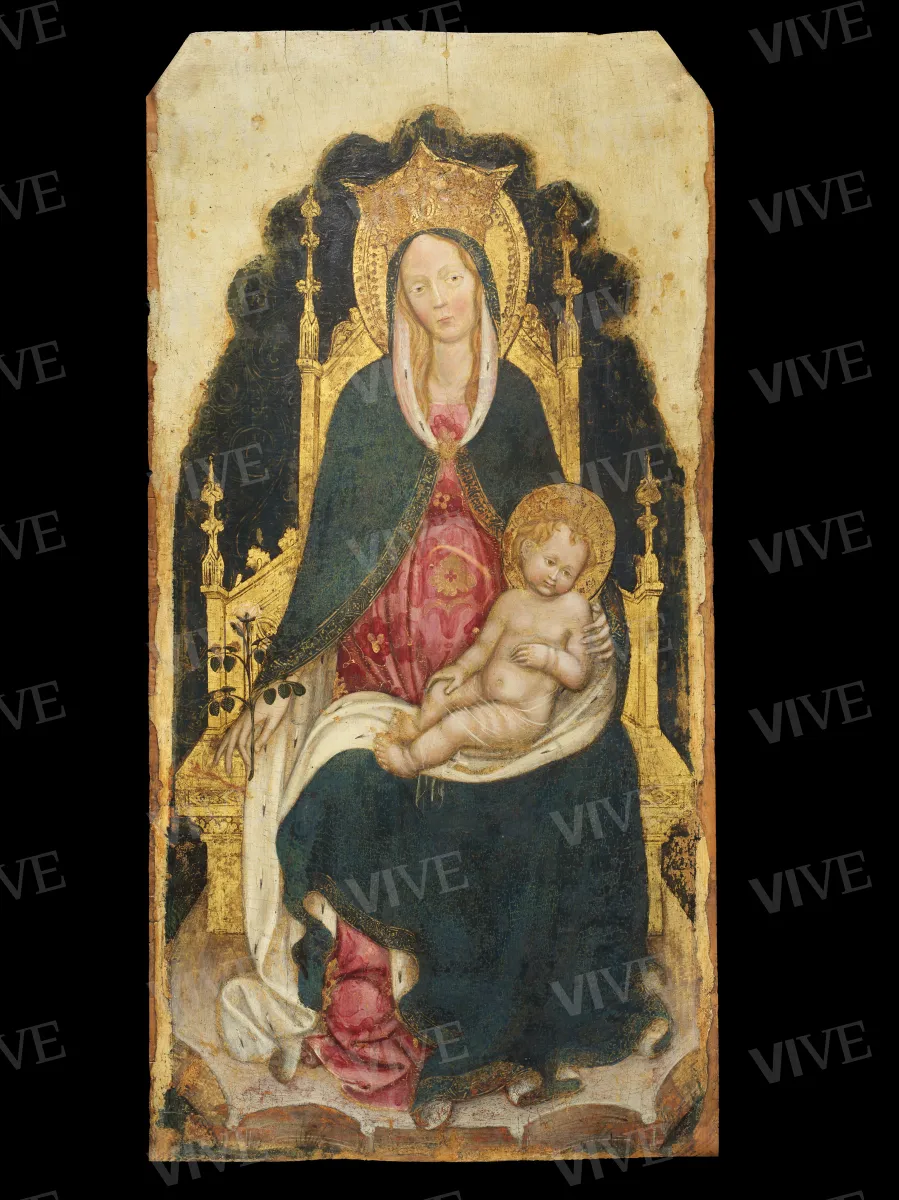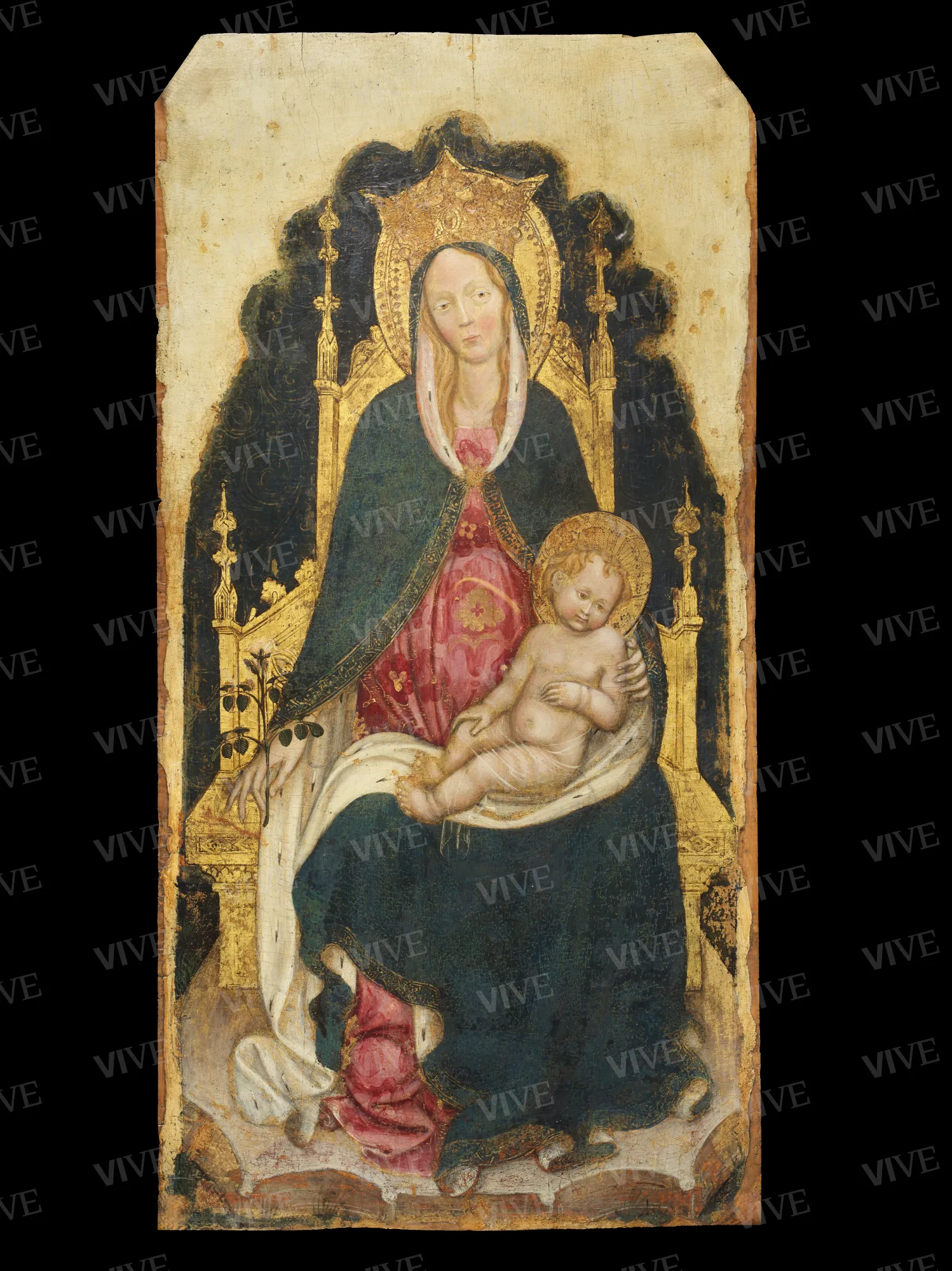Enthroned Madonna and Child
Lombard–Veneto milieu First half of the 15th century
Mary is positioned on an ornate golden throne adorned with floral motifs. Jesus, in her lap, is draped in a fold of her cloak and dressed in a delicate, transparent garment. He gazes outward, possibly towards a figure depicted on another panel within the set. The piece is likely the central panel of a polyptych, although no other elements have been identified. Traditionally attributed to Stefano da Verona, Pisanello, and Cristoforo Moretti, it is currently more cautiously credited to a Lombardy–Veneto painter from the first half of the fifteenth century.
Mary is positioned on an ornate golden throne adorned with floral motifs. Jesus, in her lap, is draped in a fold of her cloak and dressed in a delicate, transparent garment. He gazes outward, possibly towards a figure depicted on another panel within the set. The piece is likely the central panel of a polyptych, although no other elements have been identified. Traditionally attributed to Stefano da Verona, Pisanello, and Cristoforo Moretti, it is currently more cautiously credited to a Lombardy–Veneto painter from the first half of the fifteenth century.
Details of work
Catalog entry
Mary is seated on a refined golden throne adorned with floral decorations that resemble Gothic pinnacles. The structure features a mixtilinear pedestal situated on a lawn, partly visible at the lower section of the panel. Behind the figures, gilded ramages set against a dark background give the appearance of curtains, although this area has been repainted. The Virgin is dressed in a red damask tunic with gold embroidery, holding a white flower, and a blue cloak with a hood edged with ermine. Her attire, including a hem decorated with geometric patterns and golden Kufic script, has also been modified, and is secured at the neckline by a star-shaped brooch. On her head, framed by an oval halo, rests a large golden crown that is now nearly indecipherable.
Jesus is depicted seated on Mary’s knees, within the folds of her cloak. He is adorned with a light, transparent cloth and appears to be gazing out of the scene, possibly towards a figure painted on another panel of the set. This piece is likely the central panel of a polyptych, although no other elements have been identified. The history of the panel has been documented since 1907, when Berenson informed Princess von Bülow in Berlin—likely Maria Beccadelli Acton, Princess of Camporeale and spouse of the German diplomat Bernhard von Bülow. Subsequently, the panel came into the possession of Alfredo Libianchi and was acquired by the collections of Palazzo Venezia on November 7, 1922.
The literature on the panel speak to the challenges in determining its author. It has been tentatively attributed to Stefano da Verona (Hermanin 1923–1924; Sandberg Vavalà 1926, uncertain between Stefano and Pisanello; van Marle 1926; Daffra 2015, doubtfully; Christiansen 2020), to Pisanello (Santangelo 1947; Magagnato 1958; Moench Scherer 1996, doubtfully), to Cristoforo Moretti (Longhi 1928; Morassi 1930; Gengaro 1967) or to his circle (Mazzini 1958), generally to the Lombard School (Degenhart 1937; Longhi 1958) and to the circle of Giovanni Badile (Franco 1996; De Marchi 1997).
The similarities between this Madonna and the renowned Madonna of the Rose Garden in the Castelvecchio Museum in Verona (inv. 173-1B-359), discussed between Stefano and Michelino da Besozzo, and the Virgin in the lunette of the Thiene chapel in Santa Corona in Vicenza (depicting the Madonna and Child with Saints Vincent, Mark, and Felix and the commissioner Marco Thiene), frescoed by Michelino at the beginning of the 15th century, can be read as indications of reliance on a common model. The stylistic resemblance to the works of the circle of the Veronese Giovanni Badile does not provide sufficient evidence to attribute this panel to him.
It is more advisable to attribute this work to an anonymous painter who was active in Lombardy and the Veneto hinterland at the beginning of the fifteenth century. The artist’s style is firmly rooted in the late Gothic tradition, as evidenced by the sophisticated flowing drapery and the extensive use of gold.
Jacopo Tanzi
Entry published on 27 March 2025
State of conservation
Poor. The panel has experienced damage, including the loss of the gold background and altered retouching on Mary's skin and mantle.
Restorations and analyses
The work was restored in 1945 by the Istituto Centrale per il Restauro. A typed report by Alessandro Angelini (1973) documents a subsequent intervention involving the reduction and parqueting of the panel. The mark of the ancient carpentry, with a polylobed design, is still visible in the upper part of the rectangular panel, which has beveled corners at the upper edges. The wooden support has not been prepared in this area. Historical photographs (Alinari, no. 40781; Brogi, no. 23130) show that this area was covered with a dark repaint before restoration.
Provenance
Berlin, Princess von Bülow (Maria Beccadelli Acton Princess of Camporeale, 1848–1929);
Rome, Bernhard H. K. M. von Bülow, 1849–1929;
Adolfo Libianchi;
Rome, Museo Nazionale di Palazzo Venezia, purchased November 7, 1922.
Exhibition history
London, Royal Academy of Arts, Exhibition of Italian Art 1200–1900, January 1–March 8, 1930;
Milan, Palazzo Reale, Arte lombarda dai Visconti agli Sforza, April–June 1958;
Verona, Museo di Castelvecchio, Da Altichiero a Pisanello, August–October 1958;
Paris, Musée du Louvre, Pisanello. Le peintre aux sept vertus, May 6– August 5, 1996;
Verona, Museo di Castelvecchio, Pisanello, September 8–December 8, 1996;
Milan, Palazzo Reale, Arte lombarda dai Visconti agli Sforza, March 12–June 28, 2015.
References
Berenson Bernard, North Italian Painters of the Renaissance, London 1907, pp. 302, 307;
Hermanin Federico, Una tavola di Stefano da Zevio a Palazzo di Venezia, in «Bollettino d’Arte del Ministero della Pubblica Istruzione», 17, 1923-1924 [1924?], pp. 166-167;
Sandberg Vavalà Evelyn, La pittura veronese del Trecento e del primo Quattrocento, Verona 1926, pp. 286-288, 290, 306-308;
van Marle Raimond, The Development of the Italian School of Painting, The Hague 1926, VII [1923-1938, I-XIX], pp. 280-281.
Longhi Roberto, I resti del polittico di Cristoforo Morelli già in Sant’Aquilino di Milano ("Me Pinxit2), in «Pinacotheca», 2, 1928, pp. 75-79;
Mariani Valerio, La rinascita del Palazzo di Venezia, in «Capitolium», V, 1929, pp. 241-254;
Exhibition of Italian Art 1200-1900, catalogo della mostra (Londra, Royal Academy of Arts, 1 gennaio-8 marzo 1930), London 1930, p. 46, n. 30.
Morassi Antonio, La mostra d’arte italiana a Londra, in «Emporium», LXXI, 423, 1930, pp. 131-157;
Berenson Bernard, Italian Pictures of the Renaissance. A List of the Principal Artists and Their Works with an Index of Places, Oxford 1932, p. 550.
Toesca Pietro, Stefano da Verona, ad vocem, in Enciclopedia Italiana di Scienze, Lettere ed Arti, XXXII, 1936, p. 666.
Degenhart Bernhard, Stefano di Giovanni da Verona, ad vocem, Allegemeines Lexikon der Bildenden Künstler, XXXI, 1937, pp. 526-530;
Arslan Edoardo, Un affresco di Stefano da Verona, in «Le Arti», 1942, V, pp. 203-206;
Coletti Luigi, Pittura veneta dal Tre al Quattrocento, in «Arte Veneta», I, 1947, 1, pp. 5-19, 4, pp. 251-262;
Santangelo Antonino (a cura di), Museo di Palazzo Venezia. Catalogo. 1. Dipinti, Roma 1947, p. 30;
Degenhart Bernhard, Le quattro tavole della Leggenda di S. Benedetto opere giovanili di Pisanello, in «Arte Veneta», III, 1949, pp. 6-22;
Zeri Federico (a cura di), Catalogo del Gabinetto Fotografico Nazionale. 3. I dipinti del Museo di Palazzo Venezia in Roma, Roma 1955, p. 8, n. 108;
Coletti Luigi, La mostra "Da Altichiero a Pisanello", in «Arte Veneta», XII, 1958, pp. 239-250;
Longhi Roberto, Sul catalogo della mostra di Verona, in «Paragone» IX, 107, 1958, pp. 74-76;
Magagnato, in Magagnato Licisco (a cura di), Da Altichiero a Pisanello, catalogo della mostra (Verona, Museo di Castelvecchio, agosto-ottobre 1958), Venezia 1958, pp. XXVIII, XXIX, 32, 86-87, n. 91;
Mazzini, in Longhi Roberto (a cura di), Arte lombarda dai Visconti agli Sforza, catalogo della mostra (Milano, Palazzo Reale, aprile-giugno 1958), Milano 1958, p. 74, n. 233;
Podestà Attilio, Mostra della pittura veronese "Da Altichiero a Pisanello", in «Emporium», CXXVIII, 1958, 767, pp. 213-218;
Verzellesi Gian Luigi , Stefano, in «Vita veronese», 1958, 9-10, pp. 391-394;
Volpe Carlo, "Da Altichiero a Pisanello", in «Arte Antica e Moderna», 4, 1958, pp. 409-413;
Brenzoni Raffaello, Rettifiche e problemi pisanelliani in occasione della mostra in Castelvecchio, in «Atti e Memorie dell’Accademia di Agricoltura, Scienze e Lettere di Verona», X, 1958-1959, pp. 47-64;
Fossi-Todorow Maria, The Exhibition "Da Altichiero a Pisanello" in Verona, in «The Burlington Magazine», CI, 670, 1959, pp. 10-14;
Meiss Millard, An Early Lombard Altarpiece, in «Arte Antica e Moderna», 1961, pp. 125-133;
Sindona Enio, Pisanello, Milano 1962, pp. 27, 29;
Zanoli Anna, Pisanello, Milano 1964, p. s. n.;
Chiarelli Renzo, Pisanello, Firenze 1966, p. 24;
Fossi-Todorow Maria, I disegni del Pisanello e della sua cerchia, Firenze 1966, p. 4, nota 1;
Gengaro Maria Luisa , Masolino e Pisanello in Lombardia, in «Arte Lombarda», XII, 2, 1967, pp. 25-32;
Berenson Bernard, Italian Pictures of the Renaissance. Central Italian and North Italian Schools, London 1968, p. 417;
Cuppini Maria Teresa, L’arte gotica a Verona nei secoli XIV-XV, Verona e il suo territorio, III, 2, Verona 1969, pp. 211-366;
Chiarelli Renzo, L’opera completa del Pisanello, Milano 1972, p. 86;
Paccagnini Giovanni, Pisanello e il ciclo cavalleresco di Mantova, Milano 1972, pp. 141, 143-145, 162, nota 122;
Tellini-Perina Chiara, Considerazioni sul Pisanello. La monografia di Giovanni Paccagnini, in «Civiltà Mantovana», VI, 1972, 35, pp. 305-317;
Degenhart Bernhard, Pisanello in Mantua, in «Pantheon», XXXI, 1973, 4, pp. 364-441, nota 91;
Salmi Mario, Pisanello e il ciclo cavalleresco di Mantova, in «Commentari», XXIV, 1973, 4, pp. 337-341;
Zanoli Anna, Sugli affreschi del Pisanello nel Palazzo Ducale di Mantova, in «Paragone», 1973, 277, pp. 23-44;
Chiarelli Renzo, Antonio Pisano detto il Pisanello. Maestri della pittura veronese, a cura di Pierpaolo Brugnoli, Verona 1974, pp. 59-74;
Ragghianti Carlo Ludovico, Il Maestro di Sant’Apollinare, 2, in «Critica d’Arte», XX, 1974, 135, pp. 35-50;
Juren Vladimìr, Pisanello, in «Revue de l’Art», 1975, pp. 58-61;
Christiansen Keith, Gentile da Fabriano, Ithaca (N. Y.) 1982, p. 112;
Algeri Giuliana, Pisanello/Antonio Pisano, in Zeri Federico (a cura di), La Pittura in Italia. Il Quattrocento, Milano 1987, II, p. 742;
Boskovits Miklòs, Travi Carla (a cura di), Arte in Lombardia tra Gotico e Rinascimento, catalogo della mostra (Milano, Palazzo Reale, 1988), Milano 1988, p. 246.
Moench-Scherer Esther, Verona, in Lucco Mario (a cura di), La pittura nel Veneto. Il Quattrocento, I, Milano 1989, pp. 149-190;
Angelelli Walter, De Marchi Andrea, Romano Serena (a cura di), Pittura dal Duecento al primo Cinquecento nelle fotografie di Girolamo Bombelli, Milano 1991, pp. 294-295;
De Marchi Andrea, Gentile da Fabriano. Un viaggio nella pittura italiana alla fine del Gotico, Milano 1992, p. 43, nota 78;
Gagliardi Jacques, La Conquête de la peinture. L’Europe des ateliers du XIIIe au XVe siècle, Paris 1993, p. 264;
Moench-Scherer Esther, Stefano da Verona: La mort critique d’un peintre, in Rosenberg Pierre (a cura di), Hommage à Michel Laclotte. Études sur le peinture du Moyen Âge et de le Renaissance, Milano 1994, pp. 78-97;
Moench-Scherer, in Cordellier Dominique, Marini Paola (a cura di), Pisanello le peintre aux sept vertus, catalogo della mostra (Parigi, Musée du Louvre, 6 maggio-5 agosto 1996), Paris 1996, pp. 73-78, n. 34; pp. 80-82, n. 3;
Franco, in Puppi Lionello (a cura di), Pisanello. Una poetica dell’inatteso, Cinisello Balsamo 1996, pp. 121-123;
De Marchi Andrea, Ritorno a Nicolò di Pietro, in «Nuovi Studi», 2, 3, 1997, pp. 5-24, nota 61;
Daffra, in Natale Mauro, Romano Serena (a cura di), Arte lombarda dai Visconti agli Sforza, catalogo della mostra (Milano, Palazzo Reale, 12 marzo-28 giugno 2015), Milano 2015, pp. 226-227, n. III;
Christiansen Keith, Stefano da Verona: A New Work and Some Old Problems, in «Predella», 47, 2020, pp. 35-45, XXIV-XXX, nota 3;
Natale Mauro (a cura di), Federico Zeri, Roberto Longhi, Lettere (1946-1965), Cinisello Balsamo 2021, p. 92, nota 158.












